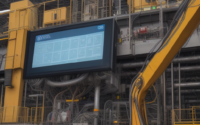Using Computer Vision in Manufacturing
Using Computer Vision in Manufacturing
Introduction to Computer Vision in Manufacturing:
Computer vision is a branch of artificial intelligence that enables machines to analyze and interpret visual information from images or videos. In the field of manufacturing, computer vision has gained significant attention due to its potential for improving quality control, efficiency, and automation.
By leveraging computer vision technology, manufacturers can optimize various processes, such as inspection, assembly, and packaging, leading to higher productivity and reduced costs. This article explores the applications and benefits of using computer vision in manufacturing.
Quality Inspection:
One of the primary uses of computer vision in manufacturing is quality inspection. Traditional manual inspections are time-consuming and prone to errors due to human fatigue or oversight. With computer vision, high-speed cameras combined with advanced algorithms can quickly and accurately identify defects or anomalies in products.
Computer vision systems can detect imperfections, such as scratches, dents, or color variations, ensuring that only products meeting the desired quality standards move forward in the production line. By automating quality inspections, manufacturers can improve the overall product quality, reduce waste, and enhance customer satisfaction.
Assembly Assistance:
Computer vision also plays a critical role in assembly processes. By equipping robots or human operators with computer vision systems, manufacturers can improve accuracy and efficiency in assembling complex products.
Computer vision algorithms can identify components, recognize their orientations, and provide real-time guidance to ensure proper placement and alignment. This technology can prevent errors, such as incorrect component installation or misalignment, ultimately leading to higher production yield and fewer rework requirements.
Object Tracking:
In manufacturing environments with a high volume of moving parts or materials, object tracking is essential to maintain smooth operations. Computer vision can track the movement of objects, such as components on a conveyor belt or materials on an assembly line.
By accurately tracking objects, manufacturers can detect bottlenecks in the production process, optimize workflows, and identify potential areas for improvement. Real-time monitoring and analysis enabled by computer vision help maximize efficiency, minimize downtime, and enhance overall productivity.
Automated Packaging:
Computer vision technology is instrumental in automating the packaging process in manufacturing. By analyzing the size, shape, and orientation of products, computer vision systems can determine the most suitable packaging solution for different items.
Furthermore, computer vision can inspect packaging materials for defects or inconsistencies, ensuring that the final packaged products meet quality standards. With automated packaging, manufacturers can increase throughput, reduce labor costs, and minimize packaging errors.
Product Traceability:
Traceability is crucial in manufacturing, particularly in industries such as food, pharmaceuticals, or electronics. Computer vision can assist in product traceability by identifying and tracking individual items or components throughout the production and supply chain.
By using computer vision-based barcode or QR code scanners, manufacturers can accurately record the movement of products, facilitating inventory management and ensuring compliance with regulatory requirements. In case of product recalls or quality issues, computer vision enables quick and precise identification of affected items, minimizing the impact on consumers and the company’s reputation.
Conclusion:
Computer vision technology offers numerous advantages in the manufacturing industry. From quality inspection to assembly assistance, object tracking, automated packaging, and product traceability, it enables manufacturers to enhance efficiency, improve product quality, and reduce costs.
As computer vision algorithms continue to advance, we can expect even more sophisticated applications and opportunities in the manufacturing sector. By embracing computer vision, manufacturers can stay competitive in an increasingly digitized and automated world.

